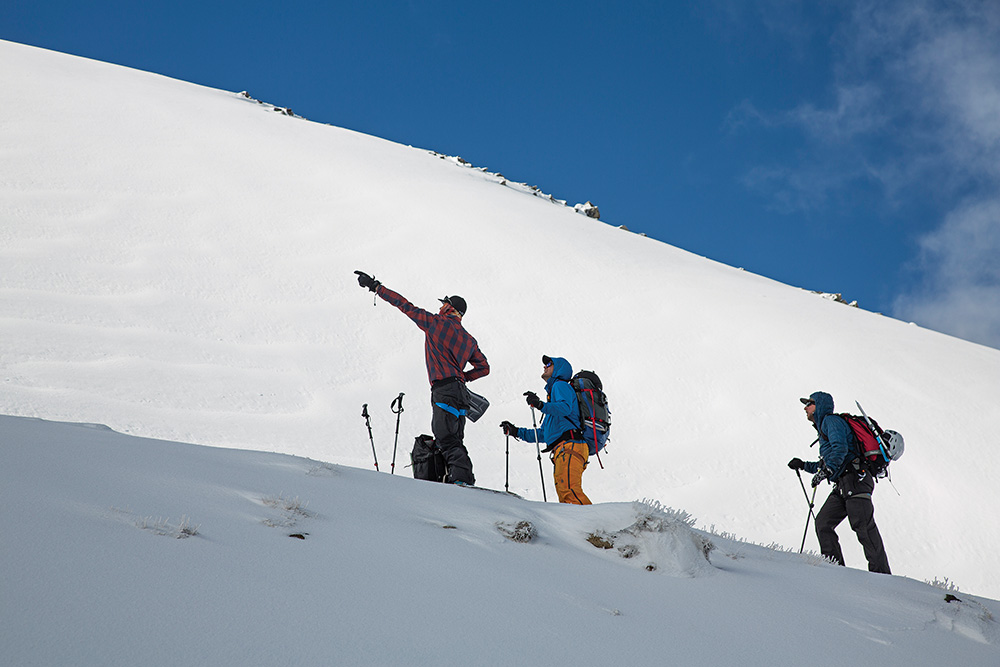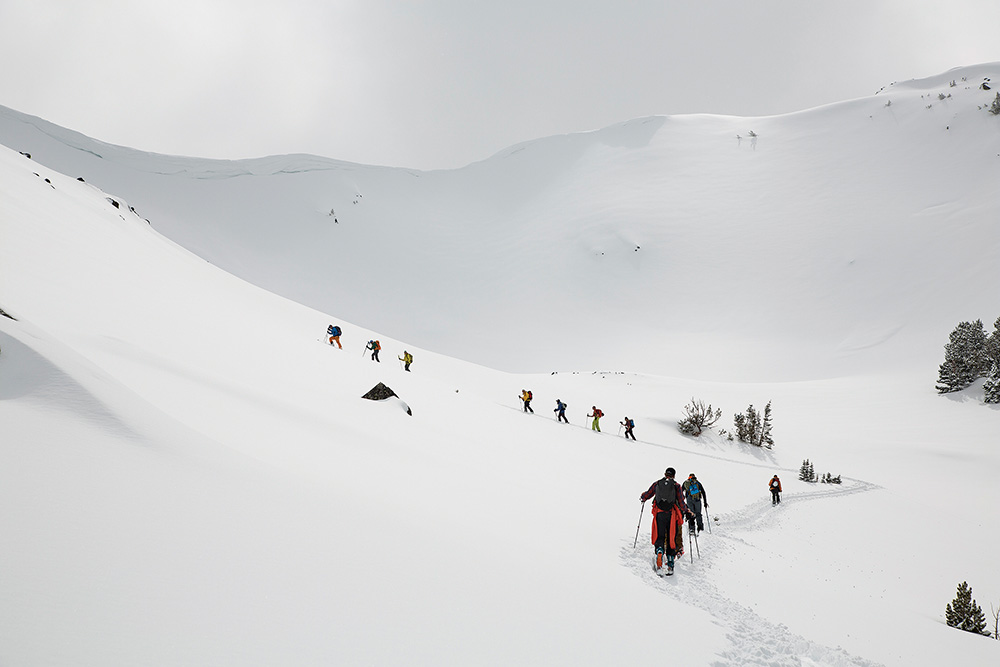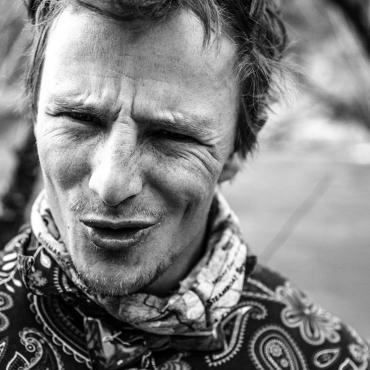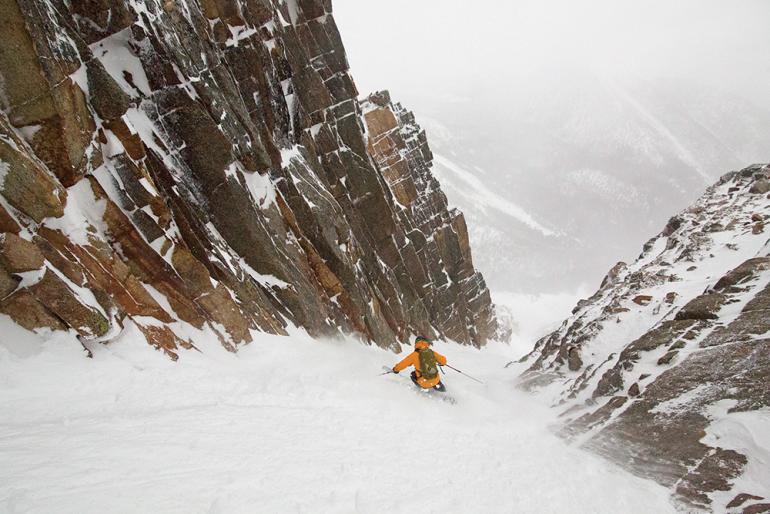When Slopes Release
An in-depth look at avalanches in the backcountry.
Nearly every outdoor activity carries its own fundamental risk. Each is a unique beast, that if tempted beyond tolerance, will sound the bell of mortality. With climbing, it is the perilous plunge of gravity; in whitewater kayaking, the recirculating hole. With backcountry travel in the winter, be it skiing, snowmobiling, or snowshoeing on an exposed ridge, it is the avalanche.
Like wildfire in summer, avalanches are a natural part of the landscape—they’re as old as the mountains they slide through. While they might not play a specific role in the ecosystem, they’re an inevitable consequence of winter in the high country. New snows fall on steep terrain, warm weather changes the density and structure of the snowpack, and wind-loading pushes slopes past the threshold of what they can physically hold. These things happen regardless of human influence, whether we’re there to see them or not. They happened before humans even had the inclination to wander into the mountains in the first place.
But things are a little different now, as people flock in ever-greater numbers to the these steep mountain slopes. The root of most avalanche disasters is people—most victims of avalanches trigger the slide themselves. Every big dump sends irresistible pulsations through the veins of thrill-seekers. And every big dump has that much more possibility of catastrophic consequences.
Since skiing in avalanche-prone terrain has slid into the mainstream, the spotlight of study is shifting from the science of snow, to the science of behavior. Unlike the hard numbers we can pull from natural factors like snowfall, temperature change, and wind-loading, the human element is more abstruse. Measuring social dynamics and psychological mindsets is challenging, as no two groups have the exact same influences operating to the same degrees. But by now, there are a lot of cases to examine, and over the years we’ve learned reliable patterns to look out for and heuristic traps we routinely fall into.
As avalanches continue to kill people year after year, we’re learning that the social powers at play carry great weight in these outcomes. Factors like group size, familiarity with the terrain, level of avalanche education, gender, and social acceptance all have dramatic influences on how a group decides to act. How much exactly? It’s hard to say, but to ignore them is naive—and negligent. And while it’s impossible to boil it down to hard-edged knowledge, with the increase in backcountry travel, avalanche education, and avalanches themselves, our understanding of it is becoming clearer.
Cold Teeth
A decision made against the elements.
by Jack Taylor

Familiarity with the area: Low
Level of avalanche training in the group: High
Number in group: Three
Clear, identifiable leader to group: No
Confidence in skills as group: High
Popularity of area: Low
“We remotely triggered a soft slab avalanche from 200 feet below and skier’s right of the start zone. 36-degree slope, northeast aspect, 9,700 feet elevation, 12-inch crown. Most of the slab fractured and stopped sliding, remaining largely intact, and a small amount of snow (size D1) slid 100 feet downslope. Strong winds were moving lots of snow off the west slope and down the canyon.”
I submitted this observation to the avalanche center on March 2, 2020. That morning, the forecast lit up like a Christmas tree. Green, green, green—the danger rating was “low” across all slope aspects and at all elevations. It was probably going to be the best ski day of our lives. We had our eyes on a king line—a 3,000-vertical-foot couloir bounded by sheer walls of towering granite.
Two days prior, the mountains had received a healthy foot of fresh snow. Calm winds and low clouds allowed the snow to settle in. We set out with a weather forecast of clear skies and calm winds, ready to claim the biggest objective we’d ever skied, with fresh powder to boot.
As we emerged from the forest and crested into the gullet of the canyon, a blast of icy wind nearly knocked us off our feet. We forged on in disbelief. What’s going on? We wondered. What happened to the forecast? We huddled in a cave to regain composure, but frigid air pierced through our clothing and muddled our disposition. We determined we were not yet in danger, and continued upward. And then, without a moment’s notice, the slope above broke into a tessellation of snowy blocks that began tumbling downhill.
We were lucky to have triggered an avalanche from an unexposed position, on a small enough slope to illustrate the extreme sensitivity of the snowpack. We knew plan A was out. We considered and eliminated plans B, C, and D, in short order.
Now came the decision: to cut our losses and retire to the trailhead, or take on a new, unplanned objective based on these unexpected conditions? It’s hard to talk through chattering teeth. We all knew what was going on with the snow, but reaching a holistic decision proved challenging. So many factors to consider, so little time to decide. We would get too cold if we stopped moving. Words turned rash and tension rose. Uncertainty led to stress, compounded by the elements.
A dark swath of rock glistened in the sun. We hastily made toward it and sprawled out. A glimmer of heat drew us closer together. We ate sandwiches and suckled our last cold drops of coffee. Bitterness turned to humor, and a sense of calm seemed to part the wind. In skiing, balance is paramount, and on a sunny day, every flying grain of snow comes from the same direction.
Across the predominant east-facing slopes speckled with a minefield of wind slabs, we spotted a narrow west-facing couloir—a mirror image of our sought-after prize. The snow would be terrible. I imagined hearing the scraping of edges on scoured névé and bracing for the unthinkable self-arrest. But we would be in control of the situation—the snow would not move beneath our feet or encapsulate us as we tiptoed through a vortex of spindrift.
That run was unforgettable, and we weren’t sure how we’d pulled it off until we were eating French fries and chicken strips in the early-springtime sun.
And so it goes. We gripe and grin, and through it all, we’re faced with unforeseen challenges. Our environment seeps into our conscience, and we play by the rules of the mountains. We learn the most from difficult experiences—we see what we’re capable of, we find our limits, and we understand our partners, and ourselves.
Communication Breakdown
Learning the hard way with a group of nine.
by Gloria Roe

Familiarity with the area: Mixed
Level of avalanche training in the group: Various; low to high
Number in group: Nine
Clear, identifiable leader to group: No
Confidence in skills as group: Medium
Popularity of area: High
“The slide initiated approximately 1,000 feet below the summit ridge. We skied down and stopped above a northeast-facing convexity. The slope steepened and ran into a gulley off the ridge we had just skied down. Winds were blowing heavily out of the southwest. The skier took two turns in the steeper terrain, planning to ski out right and onto the mellower ridge. On the second turn, she triggered an avalanche that carried her approximately 250 feet downhill.”
I sent this email to the avalanche center on January 27, 2018. When we had read the avalanche forecast that morning, we noted the danger rating was “considerable” between 9,000 and 10,500 feet, with primary concerns being wind slabs and deep slabs. With high ridgetop winds and continued snowfall, both avalanche problems would increase in danger throughout the day.
Our group of nine had converged for a long weekend and we were looking to enjoy good company, powdery conditions, and new terrain. There was a mix of familiarity with the area and a variety of backcountry experience.
We read the forecast with wary eyes, acknowledging that our group size was concerningly large and the conditions were not ideal. However, we were optimistic about managing the risks and brushed away our concerns by picking a route that was familiar, attainable, and non-committing. We didn’t want to miss out on a fun ski day with friends.
At the trailhead we went through routine checks and headed up the skintrack. Snow fell and the wind became a steadfast companion. The wide range of experience made for slow going with frequent stops to regroup and check in. Nearing the ridge, we stopped to dig a pit and produced a fracture with no propagation. We continued up.
As we climbed, the wind howled harder, and it became difficult to keep the group close. The ridgetop came as a relief. We would ski one by one and regroup in an identifiable safe spot. As we dropped down the slope, we whooped it up with fresh tracks and face shots.
When the first wave of skiers arrived at our stopping point, we rejoiced in our powdery turns and good fortune. We chatted about the next pitch. To our left, the terrain steepened slightly and funneled into a gulley. The ridge to our right was gradual and treed. The line between the two was difficult to discern.
By the time we’d all regrouped, we had a vague consensus of where we were headed. People were getting cold and there was an air of urgency to keep moving. The first skier took off, intending to go left around the trees, then cut back right.
On her second turn the snow released and we all watched in horror as our friend was swept 250 feet down into the gulley. We kept eyes on her the whole time as she managed to stay on top of the moving snow, slowing herself down after grabbing onto a small tree. When she came to a stop she stood up and waved her ski pole, indicating that she was okay.
We took stock of what happened. The crown was 125 feet wide and cut across a small rock band. The slide started above her on a small convexity in the new-old snow interface. The only thing lost in the slide was one ski pole. What we gained was an incredibly cheap lesson.
In debriefing the incident, we all had different ideas of what exactly went wrong. The common thread was a breakdown of communication. Personally, I learned that there will always be another day to ski with your friends—you don’t need to ski with all of them on the same day. Effective communication becomes increasingly difficult with a larger group size. We were cold, in a hurry, and had experienced nothing but pow turns up until the avalanche. We let our guard down and rushed through our communication.
I’m grateful that the day ended how it did. No one was hurt, and we learned a valuable lesson to take with us to the next powder day.










